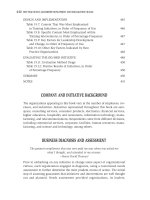Tài liệu The World in 2011 ICT Facts and Figures pdf
Bạn đang xem bản rút gọn của tài liệu. Xem và tải ngay bản đầy đủ của tài liệu tại đây (4.11 MB, 8 trang )
The World in
2011
ICT FACTS AND FIGURES
One third of the world’s population is online
45% of Internet users below the age of 25
Share of Internet users in the total population
Not using
Internet: 82%
Users, developed
China:28%
India: 6%
Other
developing
countries: 66%
Developed
Developing
Users
China: 37%
Other
developing
countries: 53%
India: 10%
Not using
Internet: 65%
Developing
Developed
Total population: 6.5 billion Total population: 7 billion
Note: * Estimate
Source: ITU World Telecommunication/ICT Indicators database
• The world is home to 7 billion people, one third of which are using the Internet. 45% of the world’s
Internet users are below the age of 25.
• Overthelastveyears,developingcountrieshaveincreasedtheirshareoftheworld’stotalnumberof
Internetusersfrom44%in2006,to62%in2011.Today,InternetusersinChinarepresentalmost25%of
the world’s total Internet users and 37% of the developing countries’ Internet users.
Internet users by age and by development level, 2011*
77%
71%
30%
23%
36%
34%
23%
29%
70%
77%
64%
66 %
0.0
0.5
1.0
1.5
2.0
2.5
3.0
3.5
4.0
4.5
Under 25 Over 25 Under 25 Over 25 Under 25 Over 25
Developed Developing World
Note: * Estimate
Source: ITU World Telecommunication/ICT Indicators database
2006 2011*
Not using Internet
Using Internet
Billions of people
Using Internet:
18%
Using Internet:
35%
• Younger people tend to be more online than
older people, in both developed and developing
countries.
• In developing countries, 30% of those under
the age of 25 use the Internet, compared to
23%ofthose25yearsandolder.
• Atthesametime, 70% of the under 25-year-
olds — a total of 1.9 billion — are not online
yet: a huge potential if developing countries
can connect schools and increase school
enrolment rates.
The World in 2011 — ICT Facts and Figures
Almost
6 billion mobile-cellular subscriptions
0
1
2
3
4
5
6
7
2006 2007 2008 2009 2010 2011*
Billions
Active mobile -broadband subscriptions
Fixed(wired) - broadband subscriptions
Fixed -telephone lines
Internet users
Mobile-cellular telephone subscriptions
Note: * Estimate
Source: ITU World Telecommunication/ICT Indicators database
Home ICT access, 2011*
Penetration developed countries
Penetration developing countries
1.8 billion households 0.7 billion households with a PC 0.6 billion households with Internet
Note: * Estimate
Source: ITU World Telecommunication/ICT Indicators database
• Of1.8billionhouseholdsworldwide,onethirdhaveInternetaccess,comparedtoonlyonefth
veyearsago.
• In developing countries, 25% of homes have a computer and 20% have Internet access, compared
to20%and13%,respectively,3yearsago.
25
74
74
71
20
• With 5.9 billion mobile-cellular
subscriptions, global penetration
reaches 87%, and 79% in the devel-
oping world.
• Mobile-broadband subscriptions have
grown 45% annually over the last
fouryearsandtodaytherearetwice
as many mobile-broadband as xed-
broadband subscriptions.
The World in 2011 — ICT Facts and Figures
Growth in bandwidth
facilitates broadband uptake
0
10’000
20’000
30’000
40’000
50’000
60’000
70’000
80’000
90’000
2001 2002 2003 2004 2005 2006 2007 2008 2009 2010 2011*
International Internet bandwidth, GBit/s
Developed
Developing
World
Note: * Estimate
Source: ITU World Telecommunication/ICT Indicators database
• InternationalInternetbandwidth,akeyfactorforprovidinghigh-speedInternetaccesstoagrowingnumber
ofInternetusershasgrownexponentiallyoverthelastveyears,from11’000Gbit/sin2006,tocloseto
80’000Gbit/sin2011.
• Disparities between regions in terms of available Internet bandwidth per Internet user remain, with on
average almost 90’000 bit/s of bandwidth per user in Europe, compared with 2’000 bit/s per user in
Africa.
0
5’000
10’000
15’000
20’000
25’000
30’000
35’000
40’000
Africa Arab States Asia & Pacic CIS Americas World Europe
International Internet bandwidth (bit/s) per Internet user, 2011*
87’395
Note: * Estimate
Source: ITU World Telecommunication/ICT Indicators database
World
Developed
Developing
InternationalInternetbandwidth,GBit/s
International Internet bandwidth (bit/s)
per Internet user, 2011*
The World in 2011 — ICT Facts and Figures
Active mobile-broadband
subscriptions reach almost 1.2 billion
Countries that offer 2G/3G services commercially, mid-2011*
Availability of 3G Networks
2G
3G
90%
45%
2G population coverage 3G population coverage
Note: * Estimate
Source: ITU World Telecommunication/ICT Indicators database
• Atotalof159economiesworldwidehavelaunched3Gservicescommerciallyandthenumberofactive
mobile-broadband subscriptions has increased to almost 1.2 billion.
• While people in developed countries usually use mobile-broadband networks in addition to a xed-
broadband connection, mobile-broadband is often the only access method available to people in
developing countries.
• The percentage of the population covered by a 2G mobile-cellular network is twice as high as the
populationcoveredbya3Gnetwork.3Gpopulationcoveragereached45%in2011.
2Gonly
2Gand3G
Topbroadbandeconomies,early2011
Economy
Fixed-broadband
subscriptions per
100 inhabitants
Economy
Active mobile-
broadband
subscriptions per
100 inhabitants*
Netherlands 38.1 Korea (Rep.) 91.0
Switzerland 37.9 Japan 87.8
Denmark 37.7 Sweden 84.0
Korea (Rep.) 35.7 Australia 82.7
Norway 35.3 Finland 78.1
Iceland 34.1 Hong Kong, China 74.5
France 33.9 Portugal 72.5
Luxembourg 33.2 Luxembourg 72.1
Sweden 31.8 Singapore 69.7
Germany 31.7 Austria 67.4
United Kingdom 31.6 New Zealand 66.2
Belgium 31.5 Kuwait 63.5
Hong Kong, China 29.9 Israel 62.2
Canada 29.8 Brunei Darussalam 61.4
Finland 28.6 Cyprus 61.3
United States 27.6 Italy 59.4
Malta 27.5 United Arab Emirates 58.4
Japan 26.9 Greece 58.3
Estonia 25.1 Saudi Arabia 57.8
Singapore 24.9 Macao, China 56.1
New Zealand 24.9 United Kingdom 56.0
Slovenia 24.2 Spain 55.7
Australia 24.2 Denmark 54.7
Macao, China 24.2 United States 54.0
Austria 23.9 Ireland 47.3
Note:Excludeseconomieswithpopulationsbelow100’000
Source:
ITU World Telecommunication/ICT Indicators databasee
*DataprovidedbyWirelessIntelligence
Europe leads the broadband race
0
10
20
30
40
50
60
Africa Asia & Pacic Arab States CIS World Americas Europe
Per 100 inhabitants
Fixed (wired)-broadband
subscriptions, 2011*
Active mobile-broadband
subscriptions, 2011*
Note: * Estimate
Source: ITU World Telecommunication/ICT Indicators database
• Europeleadsinbroadbandconnectivity,with
xed- and mobile-broadband penetration
reaching26%and54%,respectively.
• A number of developing countries have
been able to leverage mobile-broadband
technologies to overcome infrastructure
barriers and provide high-speed Internet
servicestopreviouslyunconnectedareas.In
Africa, mobile-broadband penetration has
reached 4%, compared with less than 1% for
xed-broadbandpenetration.
• The world’s top broadband economies are
from Europe and Asia and the Pacic. In
the Republic of Korea mobile-broadband
penetrationexceeds90%.
The World in 2011 — ICT Facts and Figures
Fixed(wired)-broadbandsubscriptions,2011*
Active mobile-broadband subscriptions, 2011*
The World in 2011 — ICT Facts and Figures
Broadband – speed matters
Fixed-broadband subscriptions, by speed, early 2011
• While almost all xed-broadband connections in the Republic of Korea provide speeds equal to, or
above10Mbit/s,broadbandusersinGhana,Mongolia,OmanandVenezuelaarelimitedtobroadband
speeds below 2 Mbit/s.
• AnInternetconnectionwithaspeedof256kbit/slimitsthe typesofapplicationsand servicesthat
Internet users can enjoy. Service providers for data-intensive services, such as Video-on-Demand,
recommend a minimum speed of 2 Mbit/s.
• Advertisedandrealspeedscandiffersubstantially.Insomecountries,regulatoryauthoritiesmonitor
thespeedandqualityofbroadbandservicesandobligeoperatorstoprovideaccuratequality-of-service
information to end users.
0% 10% 20% 30% 40% 50% 60% 70% 80% 90% 100%
Ghana
Venezuela
Mongolia
Jordan
Qatar
Tunisia
Colombia*
Oman
Serbia†
Morocco
Azerbaijan
Turkey
United Arab Emirates
Chile
Estonia
Ireland
Slovenia
Hungary
Slovak Republic
Germany
Switzerland
Georgia
Finland
Spain
Czech Republic
United States*††
Singapore
Denmark
Sweden
France
United Kingdom
Portugal
Bulgaria
Korea (Rep.)
≥10 Mbit/s
≥2 to <10 Mbit/s
≥256 kbit/s to <2 Mbit/s
Note:Referstoadvertisedspeeds.*Datacorrespondtoslightlydifferentspeedintervals.
†Breakdownbyspeedavailableonlyforpartofthetotalxed(wired)-broadbandsubscriptions.
†† June 2010 data.
Source: ITU World Telecommunication/ICT Indicators database
≥10Mbit/s
≥2to<10Mbits/s
≥256kbit/sto<2Mbit/s
The World in 2011 — ICT Facts and Figures
Fixed broadband prices in developing countries
drop by over 50% in just two years
2.4
1.5
112.2
0
10
30
50
70
90
110
130
150
Developed countries Developing countries
2008
-
35.4%
52.2%
Fixed telephone sub-basket
Percentage
change (drop)
between 2008
and 2010
234.9
-
2010
2.4
14.7
2.0
11.4
0
2
4
6
8
10
12
14
16
Developed countries Developing countries
2008
2010
19.1%
22.0%
Percentage
change (drop)
between 2008
and 2010
Mobile-cellular sub-basket
1.3
8.4
1.1
7.8
0
1
2
3
4
5
6
7
8
9
Developed countries Developing countries
Fixed-telephone sub-basket
2008
Fixed
-
telephone sub
-
basket
2010
9.8%
6.7%
Percentage
change (drop)
between 2008
and 2010
Source:ITUMeasuringtheInformationSociety(2011)
• The ITU ICT Price Basket
1
shows that
between 2008 and 2010 ICT services
have become more affordable and
relative prices came down by an
averageof18%,globally.
• The steepest price drop occurred in
developing countries, where xed-
broadbandpricesdroppedby52.2%.
• In developing countries, mobile-
cellular prices, which have
substantiallydroppedoverthelast
decade, fell by a further 22%.The
2010 mobile-cellular sub-basket
represented on average 11.4% of
monthly GNI per capita, compared
to 2% in developed countries.
• ICT services continue to be
more affordable in high-income
economies and less affordable in
low-income economies. By 2010,
the cost of ICT services averaged
1.5%ofGNIpercapitaindeveloped
countries,comparedwith17%ofGNI
per capita in developing countries.
• In31countries—allofthemhighly
industrialized economies — an
entry-level broadband connection
costsonaveragetheequivalentof
1% or less of average monthly GNI
per capita, while in 19 countries
— most of them least developed
countries — a broadband connection
costs on average more than 100% of
monthlyGNIpercapita.
1. The ITU ICT Price Basket is a composite measure based
onthreetariffsets—xed-telephone,mobile-cellularand
xed-broadbandInternetservices—andcomputedasa
percentageofaverageGNIpercapita.
Fixed-telephonesub-basket
2008
2010
Mobile-cellular sub-basket
2008
2010
Fixed-broadbandsub-basket
2008
2010
The World in 2011 — ICT Facts and Figures
Organized by
Hosted by
ICT
Indicators Meeting
Mauritius, 7-9 December 2011
www.itu.int/ICT/WTIM11
9th World Telecommunication
For more information:
ICT Data and Statistics Division
Telecommunication Development Bureau
International Telecommunication Union
Place des Nations
1211 Geneva 20 - Switzerland
www.itu.int/ict
© 2011, International Telecommunication Union









